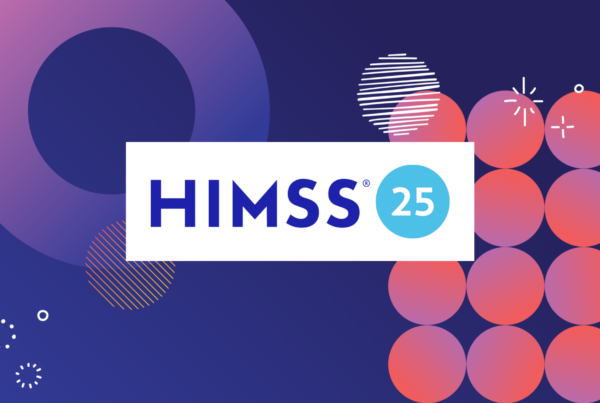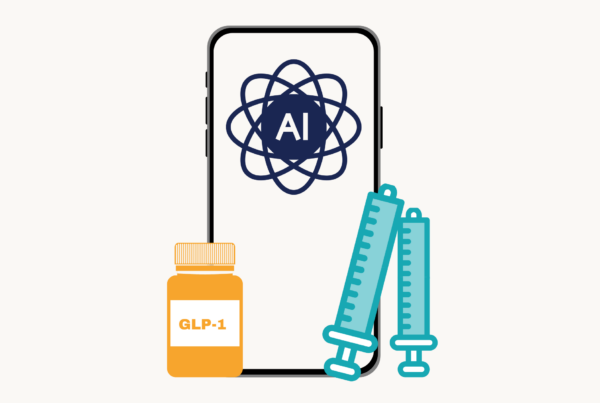From optimistic conversations on the potential of AI to wavering investor forecasts, concerns around implementing value-based care, and more, read on to learn our team’s biggest takeaways, conference surprises, and musings from four thought-provoking days in the desert.
But first, meet the dynamic Sage team in attendance at this year’s HLTH conference:
- Dan D’Orazio, CEO
- Drew Whalen, SVP BD
- Jennifer Walsh, SVP Sales
- Joshua Baracks, Senior Consultant
WHEN IT COMES TO AI, THE CAT’S OUT OF THE BAG.
Unanimously, the team agreed that artificial intelligence was the most oft-discussed topic at this year’s conference. As the first HLTH event in a post-ChatGPT world, the team observed that everyone had AI fever – it was everything, everywhere, all at once.
While CIOs, CTOs, and CMIOs (the entire C-Suite, really) all agreed that it’s no longer possible to sit on the sidelines when it comes to artificial intelligence, most reported feeling that they know they need to harness it, but don’t have an appetite for DIY. Our team expects a big year ahead of HIT companies on the hunt for the best partnerships with AI companies – and it will be HIT platforms on the hunt for AI, not the other way around.
Overall, our team detected a grand sense of optimism around the emerging tech:
- Dan D’Orazio (DD): “You could feel it – there is real hope in AI. Now that we’ve all had a taste with Chat GPT, it’s out in the open, it’s no longer the secret domain of random SMEs.”
- Josh Baracks (JB): “Everyone has ideas for its application. There’s so much value to unlock. It’ll save time, effort, improve workflows – it’ll cut costs across our high-spend industry.”
- DD: “Yeah, the sentiment was a naive, carte blanche: AI solves every problem.”
Yet, coupled with that optimism, came equal parts wariness. With ChatGPT, the AI cat is out of the bag, and no-one knows exactly where she’ll go. A recent Forbes piece – humorously titled “Are Boards Kidding Themselves About Generative AI” explored this discrepancy, citing a study that surveyed the board members of companies leveraging generative AI. Fascinatingly, 28% of respondents consider themselves “experts” on the subject – and another 39% self-rate their knowledge of AI as “advanced.”
Our team had some thoughts about that. In an industry where the Silicon Valley model of “move fast and break things” is dangerous, we should all operate with a bit more caution. Said D’Orazio: “People are excited. But, in healthcare, failing fast is not really an option. If someone calls themselves an expert, be wary.”
THE CONCEPT OF VALUE-BASED CARE NEEDS A NEW CARROT.
With a central theme of “humanity,” and many sessions on health equity, the cost-quality promise of value-based care was never far from top of mind at HLTH.
Yet, despite its outsized promise to revolutionize the healthcare landscape, organizations do not seem to be feeling motivated by the current incentives in place. The Sage team could not help but notice that some of the luster has gone out of the phrase…
- Jennifer Walsh (JW): “People are still struggling with how to implement VBC, and no matter how many come up with a new way to make an impact, it doesn’t feel like it’s making a difference in a large enough context. It doesn’t seem like we’re able to adopt it in a way that impacts the marketplace at large.”
- JB: “I know what you’re saying – I just can’t believe it, because it’s not a new thing. I know there have to be models and effective ways forward, people just aren’t doing it. The incentives just aren’t there. That’s what’s scary to me.”
- Drew Whalen (DW): “In a way, it feels similar to the AI conversation in that there is a whole lot of motivation, but not a lot of maturity. We’re all hedging our bets here, just dipping our toes in the water, trying to see what will stick and what will pay off in the long run. But it means that there’s no way to set standards or a framework around the process and help move it along.”
- JB: “It’s true. We recently spoke with an HIT leader from a large academic IDN in the midWest, who acknowledged that the incentives are not in place. They’re a giant health system and they’re already the market leader, so what is really left to encourage them to change what they’re doing? ….What if you’re the leader, you rock the boat with VBC and disrupt yourself, and then you fail? ”
Ultimately, despite HLTH’s rah-rah attitude about the transformative promise of technology, in order to truly advance VBC, tech alone won’t cut it. Widely adopted care standards and universally motivating incentives will all need to align in order to truly unlock this model’s value at scale.
THE BIG FISH ARE HUNGRY FOR MORE (RETAIL) HEALTHCARE.
This year’s conference was a glorious logo blanket for HLTH. The big players – including Amazon, Google, CVS, Walgreens*, among many others – are clearly broadcasting their intentions to gobble up as much of the healthcare space as their boards can stomach.
The team came away feeling like 2024 will bring a whole slew of M&A activity. Or, as they called it – it’s a game of Pacman, and watching some of these acquisitions will be a spectator sport:
- JB: “I think we’re going to see more people go to the big players for their interoperability solutions, their platforms; I think the appetite for smaller players is fading. Does that mean some of the bigger players are going to swallow up the smaller guys?”
- DW: “Totally. And, I think they have plenty of runway to do it. Even taking tech out of it for a second, from an access standpoint alone, the traditional players are falling short. I live in the Mass General Brigham network – arguably one of the nation’s best – and I had to beg, borrow, and steal to get a PCP appointment at the office I’ve been visiting for the last 15 years! So then you think about Walgreens and VillageMD, and you start to think, well… there is certainly a play here from an access standpoint. There is plenty of opportunity here.”
- JB: “Yeah, and then we know the competition will diminish. At HLTH, you look around and see loads of smaller vendors, and I just wonder, if you project out to HLTH in two years, how many of them will we still see here? Is it going to be different new logos fighting to get in? How many will last?”
Outside of pure market opportunity, the team could not help but acknowledge that when it comes to VBC, health equity, and care access, there may truly be the need for these newer, tech-savvy entrants:
- JW: “It’s a good point. I mean, we’re already at a shortage of nurses and doctors, and now we’re seeing all these big players get involved and maybe it will help alleviate this bandwidth burden – this access challenge we’re facing.”
- JB: “Then the question becomes – are these hospital systems failing us? Mass Brigham is interesting because they call themselves the number one health system in America, they are always top of U.S. News and World Report, but… what does it all mean if you can’t get a visit there? How are they actually good for people? Who do we need to hold accountable in healthcare – or should we welcome these retail entrants and herald this shift in the landscape?”
*Just one day after HLTH wrapped, Walgreens announced a $1 billion cost saving measure that involves shuttering at least 60 VillageMD clinics. A startling dose of post-conference reality, this news was at odds with the projection of strength shared on-site, and perhaps indicates these giants are moving a bit too quickly than is healthy.
Does it mean a retail healthcare fail? Not necessarily. Only time will tell, but it’s likely that in this climate, boards are realizing that not all that glitters is gold, and business math is the most important calculation. While we may see some closures for now, we expect to see further adjustments, as access to care remains limited in rural America and other medical deserts.
A BRIEF NOTE ON INVESTMENT APPETITE.
While the tech players may have displayed a healthy appetite for more healthcare at HLTH, industry investors were definitely feeling a little less peckish.
Our team noted it was easy to read the room, which clearly said: “wait and see!” While interoperability tools and revenue cycle solutions are notable mainstays, investor confidence in everything else feels risky at best. Sure, we came out of Labor Day saying nice things like “Q4 will be good,” as of now, we’re kicking that can down the road, and saying: “hey, maybe let’s reserve our optimism for Q1 after all…”
We’ll see you all after the New Year on that one.
LASTLY, A FEW THOUGHTS ON ‘CONFERENCE CRAFT.’
By all accounts, HLTH was a fantastic personal experience for all. The venue, while offset from the main drag, was a refreshing break from stale casino air and no sunlight. There was very little traffic and an openness that felt easy; several people remarked that they loved the Lyra Lounge, a nice break from the chaos of conference life. And, everyone rated the array of food options a steller 10/10.
The team joked that when HIT and the big VCs converge, all of healthcare’s problems seem more easily solvable:
- DD: “HLTH runs a conference the way we want to run healthcare: pristine, well-lit, a delightfully different experience.”
- JB: “Oh yeah, the HLTH version of ‘health’ is a dream world…”
Now, we’ve all got the big work of harnessing all this tech and optimism, and finding a way to make it a reality that exists outside of the convention center’s walls.






